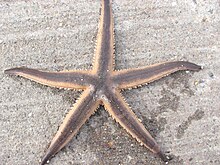| Spiny sand seastar | |
|---|---|

| |
| Scientific classification | |
| Domain: | Eukaryota |
| Kingdom: | Animalia |
| Phylum: | Echinodermata |
| Class: | Asteroidea |
| Order: | Paxillosida |
| Family: | Luidiidae |
| Genus: | Luidia |
| Species: | L. quinaria |
| Binomial name | |
| Luidia quinaria von Martens, 1865 | |
| Synonyms | |
| |
The spiny sand seastar (Luidia quinaria) is a species of starfish in the family Luidiidae. It is found in shallow parts of the China Sea and in the vicinity of the Korean archipelago. The tissues of this starfish have been found to contain several secondary metabolites with medicinal potential.
Subspecies
There are three subspecies:
- Luidia quinaria bispinosa Djakonov, 1950
- Luidia quinaria chinensis Doderlein, 1920
- Luidia quinaria quinaria von Martens, 1865
Description
Luidia quinaria has a small central disc and five long slender arms fringed with short spines. The aboral (upper) surface is covered in small paxillae, pillar-like spines with flat tops giving a smooth, table-like surface. The general colour of the aboral surface is grey with contrasting pink or orange margins to the arms. The oral (under) surface is paler.
Biology
Luidia quinaria is a predator and is found in shallow water on soft sediments. In Ise Bay in central Japan, it was found living throughout the oxygen-poor waters of the bay while another starfish, Astropecten scoparius, tended to occupy a separate zone near the mouth of the bay. Examination of the stomach contents of both starfish showed that Luidia quinaria largely fed on other echinoderms, in particular the brittle star Ophiura kinbergi, which formed more than half of the diet. The other starfish largely consumed molluscs, including the snail Voorwindia paludinoides and the clam Alvenius ojianus. The differences in the diet were thought to be due to the different availability of food items in various parts of the bay, these being due to variations in the type of sediment.
Several different biologically active steroids have been isolated from the tissues of Luidia quinaria. One of these, an asterosaponin, may prove useful in the treatment of coughs and asthma and may help clear mucus from airways.
References
- ^ Mah, Christopher (2012). Mah CL (ed.). "Luidia quinaria von Martens, 1865". World Asteroidea database. World Register of Marine Species. Retrieved 2013-01-09.
- von Martens, E (1865). "Ueber ostasiatische Echinodermen". Archiv für Naturgeschichte. 31 (1): 345–360.
- Ganmanee, Monthon; Narita, Teruyoshi; Iida, Shinya; Sekiguchi, Hideo (2003). "Feeding habits of asteroids, Luidia quinaria and Astropecten scoparius, in Ise Bay, Central Japan". Fisheries Science. 69 (6): 1121–1134. Bibcode:2003FisSc..69.1121G. doi:10.1111/j.0919-9268.2003.00737.x.
- Andriyashchenko, P. V.; Levina, E. V.; Kalinovskii, A. I. (1996). "Steroid compounds from the Pacific starfishes Luidia quinaria and Distolasterias elegans". Russian Chemical Bulletin. 45 (2): 455–458. doi:10.1007/BF01433994.
- Guo, C.; Tang, X.; Dong, X.; Yang, Y. (2009). "Studies on the expectorant, antitussive and antiasthmatic properties of asterosaponin extracted from Luidia quinaria". African Journal of Biotechnology. 8 (23): 6694–6696.
| Taxon identifiers | |
|---|---|
| Luidia quinaria | |